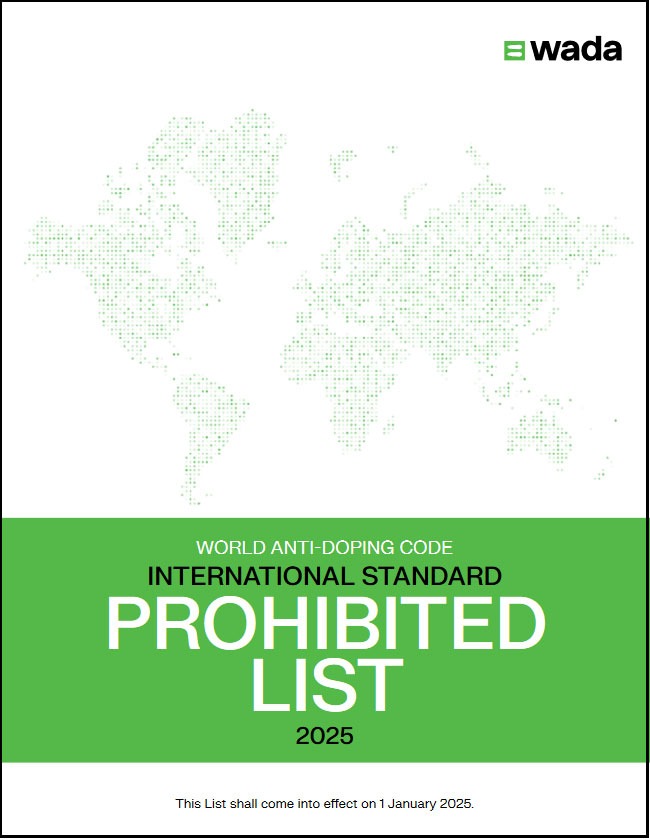
Every year, the World Anti-Doping Agency (WADA) publishes an updated Prohibited List. For 2025, there are no major status changes where a substance changes from permitted to prohibited or vice versa, but the 2025 Prohibited List does include new examples of prohibited substances and a few clarifications.
It’s important to keep in mind that the WADA Prohibited List is not exhaustive and there could be substances that are not specifically listed but still belong to a category on the Prohibited List. Before taking medications, it is important to check GlobalDRO.com and search by brand name or ingredients for the most up to date anti-doping status information.
It is important to note that under the World Anti-Doping Code, athletes are strictly liable, meaning they are ultimately responsible for what is in their systems. The 2025 Prohibited List and WADA’s explanatory note on the modifications can be found here.
New Examples and Clarifications
S0. Non-Approved Substances
In the category of S0- Non-Approved Substances, WADA has added two new examples, specifically S-107 and S48168 (ARM210). These experimental compounds are ryanodine receptor-1-calstabin complex stabilizers, which are involved in skeletal muscle function. Keep in mind, the S0 category could include substances that are not specifically indicated on the Prohibited List. If a substance is not approved for clinical use by any governmental regulatory authority and has performance enhancing potential, it may be prohibited under the S0 category.
S3. Beta-2 Agonists
The category of S3. Beta-2 Agonists has been updated with a change to the permitted use of inhaled formoterol. Formoterol continues to be permitted by inhalation up to a maximum of 54 micrograms over 24 hours, but importantly, athletes can only use a maximum of 36 micrograms over 12 hours. This is to allow athletes to use formoterol therapeutically but prevent someone from using a large dose all at once that may allow a performance benefit. We recommend checking the metered dose carefully so that the permitted inhaled dosage is not exceeded. Beta-2 agonists used by all other routes of administration remain prohibited at all times.
S4. Hormone and Metabolic Modulators
There were a few examples of S4. Hormone and Metabolic Modulators added to the Prohibited List, including elacestrant (added as an anti-estrogen), S519 and S597 (examples of insulin-mimetics), and MOTSc (an example of an AMP-activated protein kinase activator). Athletes should be aware that MOTSc is sometimes marketed by wellness/anti-aging clinics and on social media as a weight loss peptide, even though it is an experimental peptide not approved for human therapeutic use.
M.1 Manipulation of Blood and Blood Components
For 2024, WADA made a change to the M.1 category so that plasma donation (also known as plasmapheresis) is not prohibited when performed in a collection center accredited by the relevant regulatory authority of the country in which it operates. For 2025, WADA has added the clarification that this includes blood donation by apharesis, which is the medical technology that separates out the blood components and returns some of the components back to the donor. It is understood that blood components such as red blood cells will be removed and reintroduced to the circulatory system. This is normally prohibited, but WADA is allowing this procedure for donation purposes only. However, it is critical that athletes only go to legitimate donation centers and can provide documentation of the donation procedure upon request.
S5. Diuretics and Masking Agents
In the category of S5. Diuretics and Masking Agents, xipamide was added as an example.
S6. Stimulants
In the category of S6. Stimulants, midodrine and tesofensine were added as examples of prohibited stimulants, and guanfacine (sometimes prescribed for ADHD) was clarified as permitted. Athletes should be on the lookout for tesofensine in dietary supplements as it has been more commonly appearing on product labels.
—
More questions?
For questions about specific products, substances, and methods, contact USADA’s Drug Reference Line at drugreference@USADA.org or call (719) 785-2000 and follow the prompts. There is also a TUE Pre-Check Form that athletes can submit to get a quick response on whether a TUE is necessary.
—
Prohibited List Consultation Process
USADA continues to advocate for a clear and robust Prohibited List for athletes through its engagement with the WADA List Expert Group and annual stakeholder consultation process.
Comments are always welcome from stakeholders, thus we encourage you to submit comments directly to USADA at any time by email at drugreference@USADA.org.
For more information or media inquiries, click here.



